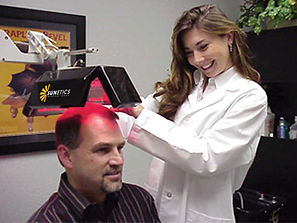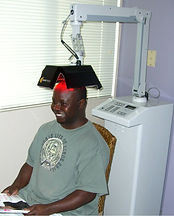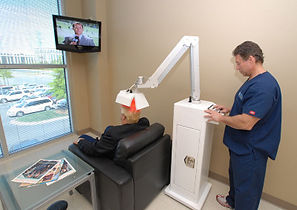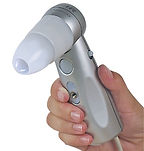Implementing the Sunetics Laser into your Practice
Whether you run a medical practice, medispa, or medically supervised clinic, implementing a Sunetics Clinical Laser Unit can be simple and effective. When implementing the unit into your practice, there are three common methods or areas in which physicians around the world have used to integrate the Sunetics Clinical Hair Growth Laser into their regular routines, depending on their current methods of hair restoration:
1. Stand-alone Therapy
2. Multi-Therapy Approach
3. Pre or Post Transplants

The Clinical Unit is EASY to Use and Operate
STAND-ALONE TREATMENT
The fact that the Sunetics Clinical Hair Growth Laser is a non-invasive, non-chemical, safe, painless, and risk free option is very appealing to patients. The laser is an incredible attraction for the people who are not yet candidates for transplants, are not interested in drug treatment, or are not interested in putting chemicals in their hair. Some of these will be women with diffuse hair loss, women post menopausal, or women who just are not candidates for a transplant. Also, young men that are early in the hair loss process and are not candidates to transplant, or men who are fearful of drugs and surgery but want to do something now about their hair loss.
The fact is that many people just do not want to do surgery or medical therapy because of the perceived side effects. So, the Sunetics Clinical Laser fits nicely into the treatment plans of many physicians and is a perfect option for this group of patients.
MULTI-THERAPY APPROACH
If a physician and patient agree it is better for the patient to utilize Propecia and or Minoxidil along with Sunetics laser hair therapy, the physician is helping the patient by giving them every treatment modality available. Many patients will like to use either Propecia and or Minoxidil along with laser hair therapy. There have been reported benefits by combining these therapies.
POST TRANSPLANT TREATMENT
If your clinic or medspa offers hair transplant services, a third option would be pre or post transplant treatment. Pretreatment of patient with laser hair therapy has been used by some physicians to help develop the donor area as well as prepare the recipient areas. This is usually four weeks prior to surgery.
Post transplant treatment with laser hair therapy has many proven benefits. First the scabbing time and would healing is greatly accelerated. Secondly, the transplanted follicles that would normally fall out due to post transplant shock stay in and remain active. It has been reported that nearly 75% of those follicles remain that would normally have fallen out. This produces a much better result for the patient. Thirdly, it has been experienced that instead of waiting four months to see the new hair growth of transplanted follicles, the time line is accelerated to seeing new growth in two months. This has added a great deal of excitement to the patient.These proven benefits alone would enhance the practice due to increasing patients' results and timelines.
IT CAN ONLY ADD TO YOUR PRACTICE!
Sunetics Laser hair therapy certainly has its limitations and will never replace transplants. As like Propecia and Minoxidil, laser hair therapy will not help in resurrecting a dead hair follicle. The physician that recognizes that Sunetics laser hair therapy is an additional tool and not a replacement to his main service (transplants), will be able to capitalize on a greater market share of hair loss individuals in his perspective area.
TRACKING RESULTS
Patient selection is crucial as well as managing their expectations of results. Tracking of results is a major key in monitoring the progress of the patient and helping them be compliant to the protocol. A Proscope or Folliscope should be used to track up close measurements of the hair shaft for density as well as new growth. Typically 3, 6, 9, and 12 months global photos and Proscope photos are taken and reviewed with the patient.
WHAT IS THE CLINICAL LASER PROTOCOL?
Most physicians will use a treatment schedule of two times per week for 12 weeks, then once every week for 12 weeks, and then once every other week (two times per month) for the last six months. The total protocol is 48 treatments during the 12 month period. Treatments are never on consecutive days. Sessions are typically 20 minute sessions.
PATIENT COMPLIANCE
The patient compliance rate has been recorded at over 90% by physicians around the world. Since hair loss is a progressive disease, those who suffer from it will go to great lengths to reverse it. The compliance rate for the Sunetics Laser Hair Therapy is very high because patients are eager to stop losing and start regrowing hair.
OPERATING THE LASER
Operating the Sunetics Clinical Laser is very simple. Typically, a patient coordinator or receptionist will sit the patient under the laser and lower the "open panel" hood by the hydraulic arm to the correct level and press two buttons and walk away. This is truly a hands-free modality.
HANDS-FREE TREATMENT
The patient can read or watch TV for the 20 minute session. The Sunetics clinical unit has an internal timer and automatic shut-off with a one minute warning signal. The laser system does not need hands-on personnel to watch over the patient during treatment. This simplicity has helped inspire many physicians to incorporate the laser into their practice.
MAINTENANCE
There is very little maintenance that is needed for the laser. Simply wipe down the glass inside the laser head to keep gels and spray residue off the glass. The laser is built to last for year of treatments.
WARRANTY
The Sunetics Clinical Laser comes with a two-year manufacturer's warranty on parts and labor on manufacturing defects. An additional three-year warranty can be purchased.

The Sunetics Laser works for ALL Ethnicities

Comfortable Treatments for Patients

Analyzing the hair shaft for density as well as for new growth.





